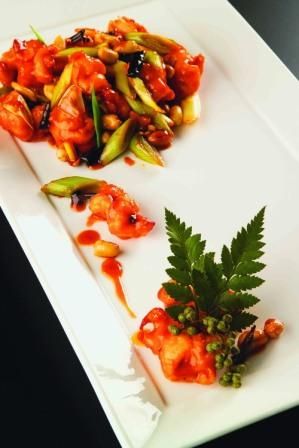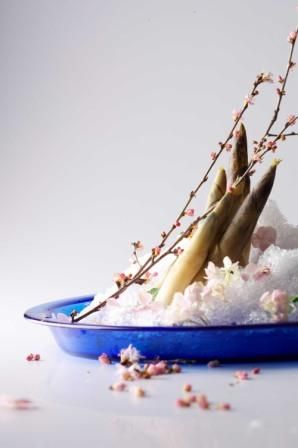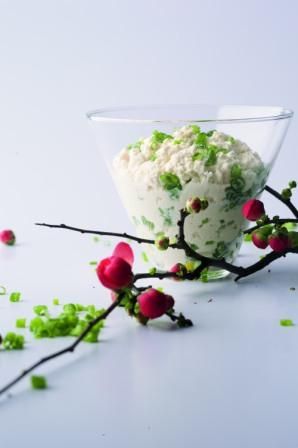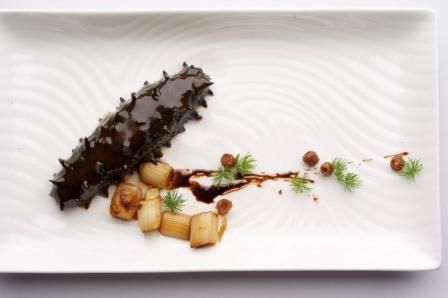大董 美仑美奂的中国意境菜
http://www.sina.com.cn 2011年04月02日 14:50 Best Food in China美食中国网
京城的东四十条甲22号南新仓,这个地址曾经是是明清两朝代京都储藏皇粮、俸米的皇家官仓,明永乐七年(1409)在元代北太仓的基础上起建,已有600余年历史。如今,位于这历史与时尚融汇之宝地的大董烤鸭店也必属非凡之所。我们此次造访的是大董烤鸭北京三家分店中的第一分店。多名服务员在餐厅入口热情恭迎,引导我们穿过大堂,直到我们在众多席位中早已安排妥当的一桌落座。环顾廊间,钧瓷坐卧,桃柳相依。餐厅餐位充足,但这并非意味着无需提前预定。我们5:30到达时,尚有大量的空余餐位,但两小时后(此时我们才算吃到一半!),整个一楼已然成为美食的海岸,引得无数味蕾的欢呼雀跃。
 宫保虾
宫保虾我们有幸见到了大董本人。他向我们介绍“以味道为核心”且“皿中有景”的意境菜,分享了将中国绘画艺术与古诗词之意境浓缩于咫尺盘盎之中的烹饪理念。
大董餐厅融汇各种菜式精华,打破了地方菜系的限制。正如大董所言,各种中式菜肴历经数千年的衍化融合,许多程式化的地域分类(如广东人不喜辣味)已不再适用现代中国。比如,北京烤鸭实际上出自山东菜系,而现在习以为常的黑胡椒和胡萝卜,历史上也是异域舶来。因为便捷的交通、现代科技以及都市化生活使得人们可以随时享用来自全国各地的菜肴。囿于成见不利于现代中式餐厅在菜品设计上推陈出新。
看到菜单上丰富的菜肴,就开始怨恨自己的胃容积太小,只能忍痛割爱重点挑选大董精心设计的春季特色菜。点好菜,接下来就是悠闲地享受美食了!
 踏雪寻梅
踏雪寻梅首先是“春歌”开胃菜,由三部分组成—一串湖虾(三只),一份小梨饼和一份香椿沙拉。我未做多想,就从左至右吃开了。串虾盛于烈酒杯中,所配沙司微甜,以绿茶粉制成。从杯中拿出串虾时,上面沾上些许绿茶酱,给人以粉嫩温润之美感。河鲜佐以微甜沙司,搭配恰到好处,味感柔美,含在口间,香郁浓沉,春天的乐章便在口中华丽地奏响。
豆腐和香椿沙拉带来温和清淡的品味,香椿还给人以滑爽香脆的口感。春饼搭配的梨片让人想起寿司餐厅里的凉姜片,但却没有姜片的那种粗硬感,而是以一种微甜的脆嫩,给三份开胃菜画上一个美妙的休止符。
 小葱拌豆腐
小葱拌豆腐接下来的一道菜展现了大董深厚的美学“功力”,遵循“意境菜”的理念——菜肴不仅要味美,同时也要“唯美”。我们所点菜肴体现的是“初春”这一主题。小葱拌豆腐搭配一条桃花枝,真是“入画之景”。豆腐清爽娇嫩,单吃或与其他菜搭配都很美味。在整个用餐过程中,我时不时地品尝,发现这道菜似乎与所有的菜都很“合味”。就连装饰性的桃花枝,我也想一同吃下!
最后一道开胃菜是酱肘花配番茄松露酱。四片圆形的甜味猪肘,配上薄荷叶盛在一小金属杯中,薄荷恰到好处地中和了甜味,而且增加了些许香脆感。最下端是一小勺柠檬冰霜,直到这里我才弄明白那个勺子的神秘用处。再加上周围的番茄沙拉和黑菌汁,整道菜美味十足,我连汁水也不留地全部吃完。
主菜之前还有一小份青柠乌鱼蛋汤——弹牙的乌鱼蛋搭配酥脆的老北京薄饼。小汤让我的胃口很自然地就适应了接下来的鲜竹笋——盛放于新竹制成的竹筒中,真是春意盎然。竹笋新鲜嫩脆,与前述之豆腐青葱搭配,一硬一软,一清一爽,妙哉妙哉。
 烧海参
烧海参董氏宫保虾上桌后紧接着就是该餐厅的招牌菜——董氏烧海参,该菜烹饪、上菜均很考究。如果说宫保虾球及所配蔬菜很可口,那么这道海参就是极为美味。海参柔润而不失韧性,搭配特制甜酸酱汁。切片利落,片形完好——均体现了极佳的烹饪技艺。实际上,许多西方人士对海参粘稠的肉质没有特别好感,但对于初尝海参佳肴并打算爱上它的人们,大董餐厅绝对是不二之选。
最后一道但美味丝毫不逊的菜肴,与这家餐厅有着二十多载的深厚渊缘——酥不腻烤鸭。皮脆肉酥的烤鸭,搭配上好的薄饼、空心烧饼、甜面酱及蔬菜,美味绝伦,怎么赞美都不为过。如果您在北京,只有亲自来品尝才能感受到如此上佳的美味。在这春光明媚的大好时节,赶快来享春季饕餮盛宴吧!
服务:很好
菜品:非常好
环境:很好
人均:200-300元
特色菜:董氏烧海参、酥不腻烤鸭、董氏宫爆虾、春歌
地址:北京东四十条甲22号南新仓商务大厦1-2楼
电话:010-5169032951690328
Location
1-2F,Nanxincang Building, No.22A, Dongsi Sitiao.//北京东四十条甲22号南新仓 商务大厦1-2楼 Tel:010-51690329 51690328
With the locations in Beijing situated in the NanxincangCultural Street and the compound of the Hong Kong Jockey Club itself, the addressesalone make it clear what kind of restaurant Da Dong Roast Duck is. Locating thefirst branch, which we visited, was not much of a problem as it occupies agiant space on both the first and second floors of the main building of thecompound. Not one but multiple attendants wait to open both of the doors thatlead you into the lobby, where more staff stand in queue waiting to direct youto one of many, many tables available – this isn’t to say, however that areservation isn’t in order. When we arrived at 5:30, there was plenty of spacebut halfway (yes, only halfway) through our meal, two hours later, the firstfloor at least was solidly packed。
We were lucky enough to meet with Da Dong himself for ourmeal, and he shared with us some of the relevant history behind the cuisine aswell as the structure and logic behind the design of a number of dishes on themenu。
The focus of the restaurant is Chinese food in general.There is in essence no particular regional bias, as Da Dong points out thatChinese cooking, in general, with its thousands of years long history anamalgamation of many different cuisines many of the “classic” components of theculinary landscape here are not in fact what most people think – Peking RoastDuck is actually from Shandong, ubiquitous black pepper and carrots are notfrom China at all, and many of the stereotypical cultural divisions betweenChinese people from different regions – Cantonese people do not like spicyfood, for instance – prove to be untrue in modern China where faster transit,modern technology and a more cosmopolitan society have made regional fare fromother parts of the country readily and cheaply available throughout most firstand second-tier cities. Thus, clinging to these divisive concepts iscounterproductive when designing a menu for a new Chinese restaurant。
The menu is massive, so to keep things manageable andbring focus onto what’s new, we set our sights upon the brand-new array ofdishes designed by Da Dong himself for this spring season specifically. Withoutfurther ado, what follows is a walkthrough of the meal, from start to end。
We started off with the appetiser titled Spring Song,three part affair consisting of a skewer of three spring shrimp, a small, coldpear cake, and a salad made of the meat of the Chinese Toon tree. Not havingany particular idea how to proceed, I took the offerings in order from left toright. The shrimp were served in a tall shot glass in a mildly sweet saucetopped with green tea powder, some of which they took with them when beingpulled out of the glass, imparting a slight grainy texture on the surface oftheir tiny, lifeless bodies, which was a nice touch. The fresh seafood tastewas a nice compliment to the slightly sweet sauce。
In the middle, the bean curd and Chinese Toon formed acool, neutral palette cleanser with a smooth feel carrying the distinct crunchytexture that Toon tree brings to dishes. The sliced cake, consisting of slicesof the fruit folded in on itself evoked notions of the cold ginger slicesserved at sushi restaurants, without the odd feeling of the friction of theginger against ones teeth that it usually imparts – it was a sweet touch thatfinished off the two more mature components of the set nicely。
The next dish was a testament to the restaurant’sdedication to presentation in line with a set of principles that form what DaDong describes as Poetically Inspired Cuisine (???) – dishes that are not justdelicious, but that also convey an artistic prospect as part of their overallcomposition, with the theme for most of our meal being the beginning of spring.We were served a “scene” of Bean Curd with Spring Shallots, presented with abranch of a fresh spring plum tree. The bean curd was excellent – cool andsoft, with just enough texture to be enjoyable on its own, yet subtle enough tostill serve well with other dishes. I continued to eat it throughout the courseof the meal, finding it went nicely with most everything. I knew the plumbranch wasn’t edible, but I was tempted to eat it nonetheless。
Our third and final appetiser consisted of four roundslices of sweet cured pork knuckle served in a small metal cup with mint, whichoffset the sweet flavour nicely and added some nice crunch. Under it all hid asmall scoop of mango sherbet, which explained the spoon that confused me untilthat point. All three components were great, as well as the surrounding tomatosalad and black truffle sauce, which I thoroughly cleaned from the plate。
A break before the main content of the meal consisted ofa small, tangy lime-flavoured squid egg soup, the chewy squid eggs accompaniedby a crunchy traditional Beijingcracker. It made for a nice transition into the fresh bamboo shoots – a classicsymbol of spring, served in containers of fresh bamboo themselves. The shootswere incredibly fresh and tender, and made for an excellent combination withthe aforementioned bean curd。
Kung Pao Prawns were rolled out and quickly overshadowedby the presentation of one of the house specialties, Sea Cucumber, preparedwith much affair tableside. The prawns as well as the vegetables served withthem were great, but the Sea Cucumber was just superb. It was moist and onlyslightly chewy, served in a special house sauce that was sweet and tangy. Itsliced easily, held its shape on the plate, and didn’t deflate – all signs ofan excellent serving of the leathery animal. In honesty, most westerners willprobably not enjoy the sticky, gooey texture of the holothurian, but if onedesires to try the dish for the first time, this would be the place to do it。
Last and most definitely not least came the Peking Duck –it was great. The skin was crunchy, the meat was soft, the pancakes, sauce, andvegetables that accompanied it were all first-rate. It was everything the dishshould be, presented nicely, and no amount of adjectives of wordplay would haveany more value than my direct recommendation – if you are in Beijing, you should head over and try thedish yourself. You can afford to splurge – it’s springtime。
-- by Moy Hau
Service quality: very good
Food quality: excellent
Environment: very good
Price per head (RMB): 200-300
(作者:Moy Hau 翻译: 陈宇平)
